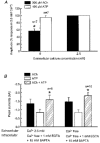Non-additive interaction between nicotinic cholinergic and P2X purine receptors in guinea-pig enteric neurons in culture
- PMID: 9824710
- PMCID: PMC2231316
- DOI: 10.1111/j.1469-7793.1998.685ba.x
Non-additive interaction between nicotinic cholinergic and P2X purine receptors in guinea-pig enteric neurons in culture
Abstract
1. Acetylcholine (ACh)-activated currents and their interaction with ATP-activated currents were studied in primary cultures of myenteric neurons from guinea-pig small intestine using patch clamp techniques. Peak currents caused by co-application of ACh (1 mM) and ATP (300 microM) were 78 +/- 2 % of the sum of currents activated by each agonist alone (P < 0.05, n = 29). Reversal potentials measured during co-application of ACh and ATP did not differ from those measured during application of ACh or ATP alone. Addition of BAPTA (10 mM) to the pipette solution or replacement of extracellular Ca2+ with Na+ did not prevent occlusion. 2. Responses caused by co-application of 5-HT (300 microM), acting at 5-HT3 receptors, and ACh (3 mM) or ATP (1 mM) were additive (94 +/- 3 or 96 +/- 4 %, respectively, of the sum of currents activated by 5-HT and ACh or ATP alone; P > 0.05). Currents caused by GABA (1 mM), acting at GABAA receptors, and ACh (3 mM) or ATP (1 mM) were also additive (105 +/- 4 or 100 +/- 3 %, respectively, of the sum of currents activated by GABA and ACh or GABA and ATP applied separately; P > 0. 05). 3. Single channel currents caused by ACh and ATP in the same outside-out patches were less than additive (85 +/- 10 % of the predicted sum, P < 0.05). 4. P2X receptors and nicotinic cholinergic receptors (nAChRs) are linked in a mutually inhibitory manner in guinea-pig myenteric neurons. The functional interaction does not involve ligand binding sites, Ca2+-dependent mechanisms, a change in the driving force for Na+ or cytoplasmic signalling mechanisms.
Figures





 ) with 2.5 m
) with 2.5 m




Comment in
-
Cross-talk between apparently independent receptors.J Physiol. 1998 Dec 15;513 ( Pt 3)(Pt 3):629-30. doi: 10.1111/j.1469-7793.1998.629ba.x. J Physiol. 1998. PMID: 9824704 Free PMC article. No abstract available.
Similar articles
-
Functional interactions between nicotinic and P2X channels in short-term cultures of guinea-pig submucosal neurons.J Physiol. 1998 Dec 15;513 ( Pt 3)(Pt 3):671-83. doi: 10.1111/j.1469-7793.1998.671ba.x. J Physiol. 1998. PMID: 9824709 Free PMC article.
-
Mutual occlusion of P2X ATP receptors and nicotinic receptors on sympathetic neurons of the guinea-pig.J Physiol. 1998 Aug 1;510 ( Pt 3)(Pt 3):783-91. doi: 10.1111/j.1469-7793.1998.783bj.x. J Physiol. 1998. PMID: 9660893 Free PMC article.
-
Calcium flux through predominantly independent purinergic ATP and nicotinic acetylcholine receptors.J Neurophysiol. 1997 Mar;77(3):1407-17. doi: 10.1152/jn.1997.77.3.1407. J Neurophysiol. 1997. PMID: 9084606
-
Alcohol action on membrane ion channels gated by extracellular ATP (P2X receptors).Neurochem Int. 1999 Aug;35(2):143-52. doi: 10.1016/s0197-0186(99)00056-x. Neurochem Int. 1999. PMID: 10405998 Review.
-
Pharmacology and electrophysiology of ATP-activated ion channels.Trends Pharmacol Sci. 1992 Mar;13(3):87-90. doi: 10.1016/0165-6147(92)90032-2. Trends Pharmacol Sci. 1992. PMID: 1374198 Review. No abstract available.
Cited by
-
Interaction of P2 purinergic receptors with cellular macromolecules.Naunyn Schmiedebergs Arch Pharmacol. 2008 Mar;377(1):1-33. doi: 10.1007/s00210-007-0222-2. Epub 2007 Dec 19. Naunyn Schmiedebergs Arch Pharmacol. 2008. PMID: 18273661 Free PMC article. Review.
-
5-HT4 receptor activation facilitates recovery from synaptic rundown and increases transmitter release from single varicosities of myenteric neurons.Am J Physiol Gastrointest Liver Physiol. 2008 Jun;294(6):G1376-83. doi: 10.1152/ajpgi.00078.2008. Epub 2008 Apr 24. Am J Physiol Gastrointest Liver Physiol. 2008. PMID: 18436623 Free PMC article.
-
GABA(A) Receptors: Post-Synaptic Co-Localization and Cross-Talk with Other Receptors.Front Cell Neurosci. 2011 Jun 22;5:7. doi: 10.3389/fncel.2011.00007. eCollection 2011. Front Cell Neurosci. 2011. PMID: 21734865 Free PMC article.
-
An angstrom scale interaction between plasma membrane ATP-gated P2X2 and alpha4beta2 nicotinic channels measured with fluorescence resonance energy transfer and total internal reflection fluorescence microscopy.J Neurosci. 2005 Jul 20;25(29):6911-20. doi: 10.1523/JNEUROSCI.0561-05.2005. J Neurosci. 2005. PMID: 16033901 Free PMC article.
-
Subtype-specific mechanisms for functional interaction between α6β4* nicotinic acetylcholine receptors and P2X receptors.Mol Pharmacol. 2014 Sep;86(3):263-74. doi: 10.1124/mol.114.093179. Epub 2014 Jun 25. Mol Pharmacol. 2014. PMID: 24966348 Free PMC article.
References
-
- Bean BP. Pharmacology and electrophysiology of ATP-activated ion channels. Trends in Pharmacological Sciences. 1992;13:87–90. - PubMed
-
- Brake AJ, Wagenbach MJ, Julius D. New structural motif for ligand-gated ion channel defined by an inotropic ATP receptor. Nature. 1994;371:519–523. - PubMed
-
- Chen C-C, Akoplan AN, Sivilotti L, Colquhoun D, Burnstock G, Wood JN. A P2X purinoceptor expressed by a subset of sensory neurons. Nature. 1995;377:428–431. - PubMed
Publication types
MeSH terms
Substances
Grants and funding
LinkOut - more resources
Full Text Sources
Miscellaneous

